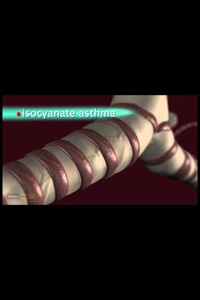Isocyanates
Isocyanates can cause serious respiratory issues, including asthma. Isocyanates result from chemical reactions in plastics and polyurethanes. Workers who manufacture plastics or apply polyurethane coatings may be at risk of exposure.
- How workers are exposed
- The risks
- How to reduce the risks
- Resources
How workers are exposed
Inhalation is the most common form of exposure for workers. Isocyanates can also enter a worker's body through unprotected skin. Plastics release isocyanates into the air during manufacturing. Applying polyurethane products such as insulating spray foams, varnishes, paints and coatings will also release isocyanates.
Workers are most commonly exposed in the following industries:
| Auto body and automotive painting |
|
| Construction |
|
| Manufacturing |
|
| Industrial coatings |
|
The risks
Short-term exposure to isocyanates can cause minor health issues. Long-term exposure can cause a form of asthma. Workers can also become so sensitive to isocyanates that they can no longer work when the chemicals are present. This could force workers to change careers.
The most common health issues caused by these chemicals are the following:
| Short-term exposure |
|
| Long-term exposure |
|
How to reduce the risks
When working with materials containing isocyanates, workers should always wash their hands before eating. They should immediately wash any skin contaminated by isocyanates. They should also leave work clothes at work, so their families don't get exposed to isocyanates.
If workers notice any health effects, they should notify a supervisor right away and see a physician.
The most effective way to reduce the risk of exposure to isocyanates is to eliminate the source of exposure. If that's not possible, there are other risk controls to use. When choosing risk controls, start by asking yourself the questions in the following steps. The steps are listed in order of effectiveness.
-
1
Elimination or substitution
Eliminating the hazard by substituting a safer process or material, where possible, is the most effective control. Some questions to consider:
- Can isocyanate-free products be used?
- Can an application process that generates fewer isocyanates or a less hazardous isocyanate be used?
-
2
Engineering controls
Making physical modifications to facilities, equipment, and processes can reduce exposure. Some questions to consider:
- Can ventilation be improved?
- Can barriers be put up to prevent unauthorized access to the worksite during the application of products containing isocyanates?
- Has all spray (and other) equipment been regularly maintained and checked before use?
-
3
Administrative controls
These involve changing work practices and work policies. Providing awareness tools and training also count as administrative controls. All can limit the risk of isocyanates exposure. Some questions to consider:
- Have you developed a written exposure control plan for isocyanates?
- Have you developed a ventilation plan?
- Can warning signs be posted in the work area?
- Can changing facilities that have separate lockers for workers' work and street clothes be provided?
- Can workers be scheduled away from isocyanate-generating processes?
- Have you developed emergency cleanup procedures for isocyanate spills?
-
4
Personal protective equipment
This is the least effective control. When used, there must always be at least one other control in place as well. Some questions to consider:
- Do workers have the proper respirators, eye wear, and protective clothing?
- Has personal protective equipment been tested to make sure it is working properly?
- If you use air purifying respirators, do you have a cartridge changing schedule?


